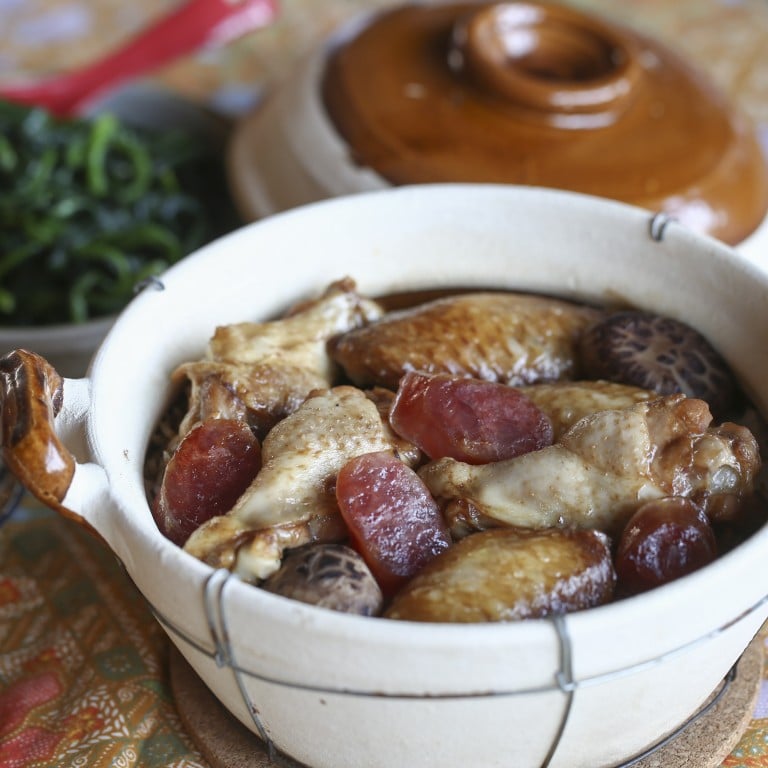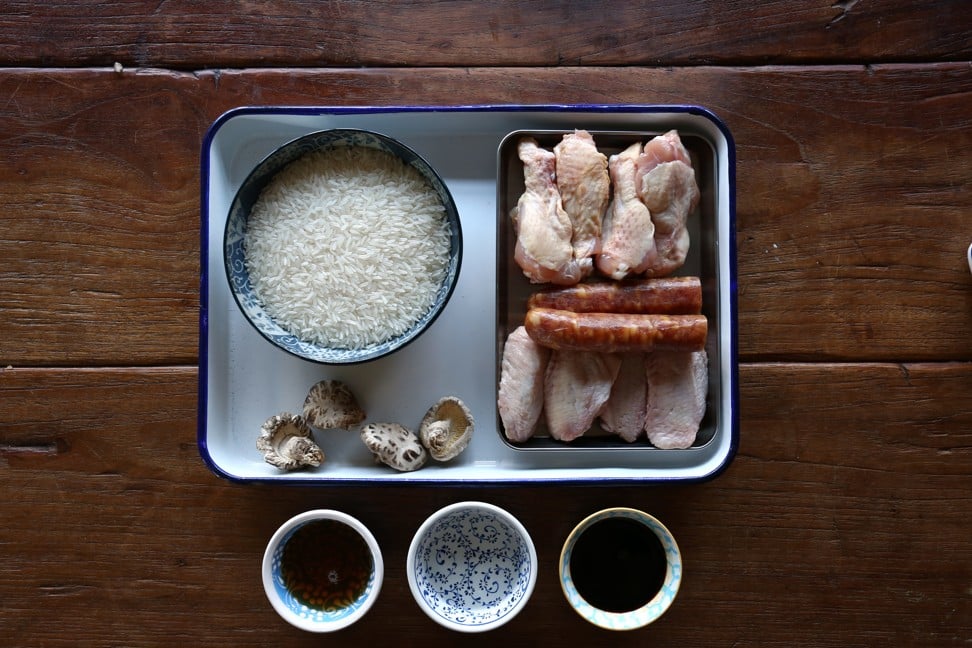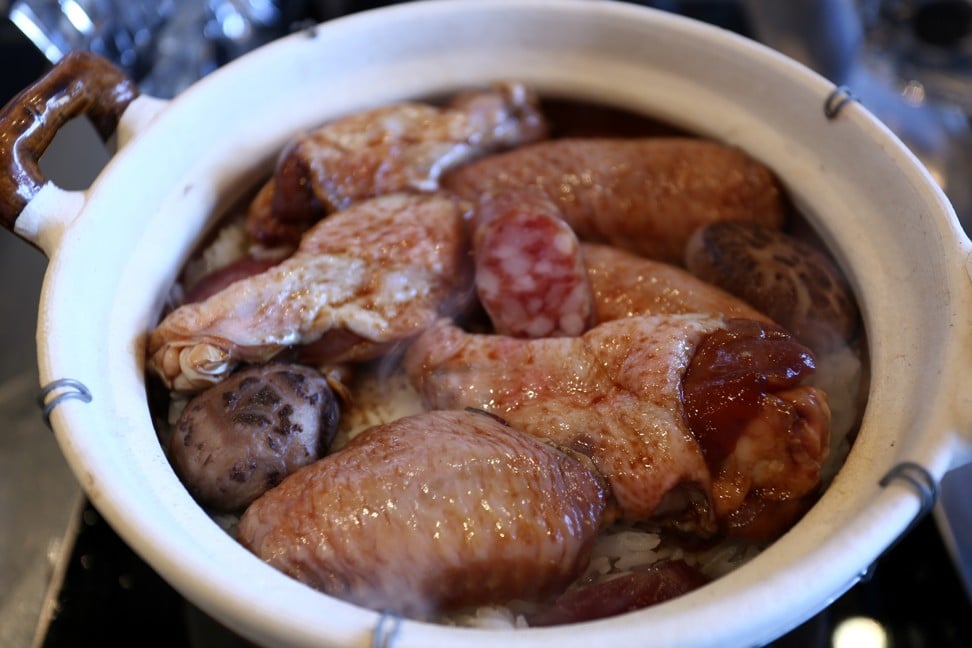
How to cook clay pot rice – a classic Cantonese comfort food and winter warmer
- The secret to good bo jai fan is simple, it’s all in the amount of water you use
- Resist lifting the lid on the clay pot while it’s cooking, instead employ your senses to check that it is done
I love to watch the professionals make bo jai fan (clay pot rice) – they do it with such ease, moving the pots from one blazing hot burner (charcoal, please – it tastes better) to a slightly cooler one, then back again. It’s hard to make bo jai fan better than the shops that specialise in it because it’s something they make day after day (at least during the cooler weather). But that doesn’t mean you can’t make good bo jai fan on a gas stove in your own kitchen.
Bo jai fan with chicken wings, lap cheong and mushrooms
With bo jai fan, you need to use a little more water than you would for plain rice, because whatever ingredients you put on top need to steam until they’re cooked. You’ll be using at least four of your senses when making the dish: your sight, to see if there’s steam coming through the hole in the lid of the pot (if there’s no steam, it means there’s no more liquid, and if the rice is not ready, you’ll need to add a splash of water); your smell, to sniff out if the rice is burning – there’s a fine line between a nice brown crust (which you want) and one that’s burnt; your hearing, because if you listen carefully, you can detect the faint crackling sound of the rice browning on the bottom of the pot; and your taste, to check that the rice is done. It’s important to resist lifting the lid before everything is cooked unless it’s absolutely necessary, such as when you need to add more water.
The best restaurants have their own secret recipes for the sauce that is stirred into the bo jai fan just before it’s eaten. It’s not just soy sauce, which would be one-dimensional and far too salty. I like to mix kecap manis – a rich, thick soy sauce (use the ABC brand from Indonesia) – with other seasonings.

250 grams long-grain rice
2 dried mushrooms, about 3.5cm in diameter
4 chicken wings – drumette and middle joints only
15ml soy sauce
10ml rice wine
¼ tsp fine sea salt
½ tsp granulated sugar
A pinch of finely ground white pepper
5ml sesame oil
1 tsp cornstarch
2 lap cheong (Chinese sausage, or you can use one each of lap cheong and yuen cheong [liver sausage])
2 spring onions
For the sauce:
30ml kecap manis
15ml soy sauce
10ml rice wine
5 grams sugar
5ml sesame oil
How to cook rice perfectly: all you need to know
1 Put a bowl on the scale and weigh out the rice. Leave the scale on and do not press the tare button. Rinse the rice several times until the water is almost clear, then drain it and put it back on the scale. Add more water so the total weight of rice and water is 600 grams. Put the rice and water in a clay pot with a capacity of about 1.5 litres and leave to soak for at least an hour.
2 Rinse the dried mushrooms then put them in a bowl and add hot water to cover. Leave until fully hydrated, then squeeze out the excess moisture and trim off and discard the stems. Cut each mushroom in half.
3 Cut the chicken wings between the joints, so you have four pieces each of drumettes and middle joints. Put the chicken in a bowl and add the soy sauce, rice wine, salt, sugar, pepper, sesame oil and cornstarch. Mix well, then leave to marinate for at least 15 minutes. Cut the lap cheong on the diagonal into 1cm pieces. Cut the spring onions into 3mm pieces.
Susan Jung’s recipes for ‘laap mei’ – wind-dried meats
4 Place the clay pot over a high flame and cook until the water is bubbling vigorously around the sides of the pot. Place the chicken wings (but discard the excess marinade) over the rice then add the mushrooms and lap cheong. Arrange the ingredients loosely, and so there are several gaps over the rice – you don’t want to pack them in so tightly that the steam can’t escape. Cover the pot with the lid and continue to cook until you see steam coming out of the hole and around the sides of the lid.
Cook over a high flame for five minutes. Reduce the flame to medium-high and cook for five minutes, then turn the heat to medium-low and cook until the rice is done (about 10 more minutes). If at any time before the rice is done you smell the ingredients burning, or if there’s no steam coming out of the pot, add a splash of boiling water (cold water might crack the pot).
5 As the rice is cooking, mix the sauce ingredients in a small pan and bring to a simmer. Taste the sauce and adjust the seasonings, if needed.
Susan Jung’s recipes for shrimp pasta and fried rice
6 When the rice is done, turn the flame to high and cook, with the pot covered, until you can smell the rice starting to toast and brown – it will smell appetisingly scorched, but not acrid/burned. Take the pot from the heat.
7 Remove the lid and take several of the chicken pieces out of the pot. Spoon about one-third of the sauce over the rice and leave for about 30 seconds so that it has time to trickle down to the bottom of the pot – you’ll hear it sizzling. Mix the ingredients to distribute the sauce throughout the rice, adding more sauce if needed, then place the chicken wings back in the pot and sprinkle with spring onions. Scoop the ingredients into individual rice bowls, making sure each person gets an equal amount of the brown rice crust, and drizzle each portion with more sauce, if desired. Serves two.

Variations:
1 Omit the chicken and mushrooms, and use only air-dried meats: two lap cheong, two yuen cheong, several 5mm-thick slices of Chinese bacon (lap yuk) and a salted duck (lap ngap) thigh that’s been cut through the bone into four pieces. Place the meats over the rice as soon as the water in the pot comes to the boil.
2 Omit the chicken and mushrooms. Mix about 350 grams of minced beef with a little soy sauce, rice wine, salt, sugar, white pepper and cornstarch, then add some finely chopped chun pei (dried tangerine peel) that’s been soaked in warm water until pliable. Shape the meat into a patty and place it over the rice when the water boils. When the rice and meat are cooked, crack a raw egg over the meat patty, put the lid back on the pot and let it steam for a few more minutes, or until the egg is gently set.
3 Omit the chicken and mushrooms. Mix about 300 grams of minced pork with a little soy sauce, rice wine, sugar, salt, white pepper and cornstarch. Shape the meat into a patty and place it over the rice when the water boils, then add a piece (about 2.5cm wide) of salted fish that’s been rinsed under running water.

